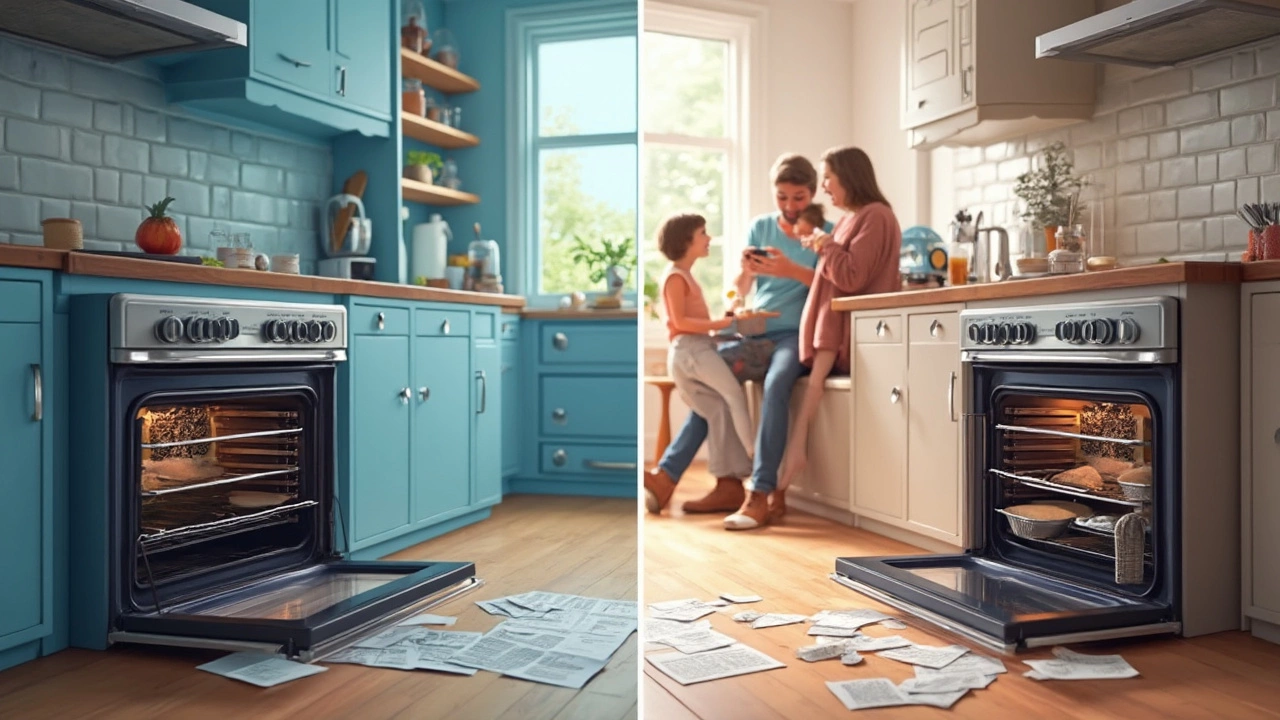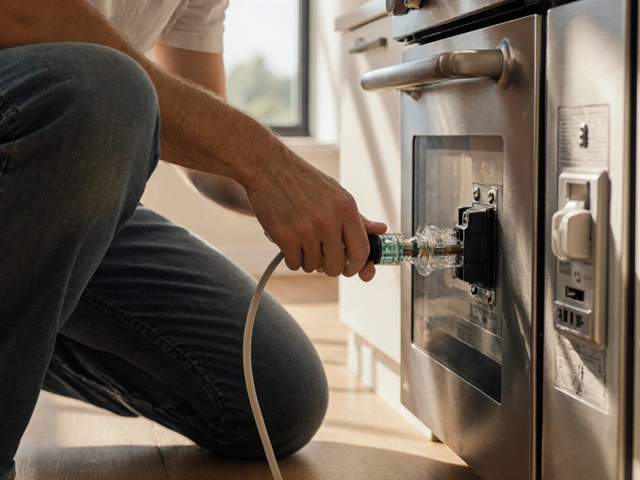You've probably stood in your kitchen, staring at an oven that's acting up, wondering if it's time to call it quits or try to fix it. Repairing a 5-year-old oven isn't always a straightforward decision. So, how do you decide if it's worth the hassle?
First, consider the problem itself. Some issues are minor and can be fixed without breaking a sweat. Think about common problems like a broken heating element or faulty thermostat—these are generally easier on the wallet when it comes to repairs.
But it's also important to think about costs. Repairs usually cost anywhere from $100 to a few hundred bucks, depending on the complexity. If your repair bill starts inching toward the cost of a new unit, that's a good sign it might be time for an upgrade.
- Understanding the Value of Your Oven
- Common Issues and Repair Cost
- DIY or Call the Pros?
- When Replacement Makes More Sense
- Maximizing the Lifespan of Your Oven
Understanding the Value of Your Oven
When you first bought your oven five years ago, it was probably a shiny gem in your kitchen. Over time, like anything else, it started to show some wear and tear. But before you decide to repair or replace, it’s crucial to understand its current value.
First thing's first: does it meet your current cooking needs? Maybe you’ve started baking more bread or ventured into making homemade pizzas. If the oven's performance can’t keep up, it might not hold much value for you anymore, even if it’s in solid shape.
Let’s talk dollars and cents. Ovens have an average lifespan of around 13 to 15 years. So, if it's still performing well, repairing is typically more cost-effective than replacing an oven just because it's half that age.
Next, check out the brand and model. High-end models might be more worth the investment to fix than a basic model. Plus, certain brands have more durable parts that, even after a half a decade, hold up better.
And don't forget energy efficiency! Older models might not be as efficient, leading to higher electricity bills. With energy costs on the rise, a less efficient oven could cost more in the long run. Sometimes, the potential savings on your energy bill are enough to tip the scales toward a new purchase.
Assessing Repair vs. Replacement Value
To break it down, here’s a simple way to evaluate:
- Calculate the estimated cost of repair.
- Look up the average price for a similar, new oven.
- Factor in energy efficiency savings.
- Consider how much you’ve already spent on repairs in the past.
If all these factors suggest that repair costs approach or surpass half the price of a new oven, you might be better off saying goodbye to your old friend. But if costs are significantly lower and it still serves its purpose, repairing might just be the wise move.
Common Issues and Repair Cost
Dealing with electric oven repair often starts with identifying the problem. Understanding what's gone wrong is crucial to figuring out whether fixing it is worth your time and money.
Frequent Problems
A few typical issues can plague a 5-year-old oven. Broken heating elements are quite common—if your oven isn't heating evenly, that might be your culprit. These elements can cost around $150 to replace, parts and labor included.
Then there's the case of a wonky thermostat. If your oven's temperature is consistently off, it might be this little device at fault. Repairing or replacing a thermostat typically sets you back about $100.
Electronic control failure can also be a thorn in your side, particularly with newer models. These parts can be pricey, with repairs often around $300. If it gets close to half the price of a new oven, it's time to consider your options.
Diagnostic Approach
Start by narrowing down the issue. Check if there's a power supply problem—this seems simple, but it’s a common oversight. If everything's plugged in and getting juice, move on to other possibilities like heating elements or control panels.
- Inspect visible elements for wear and tear.
- Test the oven's functionality using different settings—this can help pinpoint if the issue is with specific elements.
- Listen for unusual sounds; strange noises can indicate a mechanical issue.
Comparing Costs
Repair costs can add up quickly. Compare them with replacement costs. If you’re looking at potentially expensive repairs, check out deals on new models. Here’s a quick comparison table:
| Repair Type | Average Cost | Replacement Oven Range |
|---|---|---|
| Heating Element | $150 | $400 - $800 |
| Thermostat | $100 | $400 - $800 |
| Control Board | $300 | $400 - $800 |
Remember, sometimes replacing an oven is the more savvy decision, especially if it's a repeat offender with many small fixes accumulating over time.

DIY or Call the Pros?
Alright, so your oven's acting up. Before you grab a screwdriver or your phone to call in an expert, it’s worth asking yourself one question: Can I handle this? There are some oven problems that even the least handy person can tackle.
When DIY Makes Sense
For simple fixes like a heating element that needs replacing or a dodgy thermostat, you might want to try going the DIY route. These are generally straightforward tasks—the part itself usually costs less than $50. Plus, there’s a ton of tutorial videos online to guide you through the process.
- Make sure the oven is unplugged before doing any repairs.
- Have the model number handy to ensure you're buying compatible parts.
- Pay attention to safety precautions mentioned in tutorials.
These easy repairs might save you a good chunk of change.
When It’s Time to Call the Pros
Now, if you're dealing with more complex issues, like electrical problems or consistent heating failures, it's best to leave it to the experts. Messing around with serious electrical components without proper knowledge can be risky business.
"If you find yourself repeatedly fixing the same problem, it's a sign that something bigger is amiss," says Sarah Thompson, a seasoned appliance repair technician.
Professional repairs could seem costly at first—usually between $100 to $400—but they often ensure longevity and peace of mind. Remember, a pro can also spot other lurking issues that you might miss.
Deciding whether to opt for electric oven repair by yourself or hire a professional largely depends on your comfort level and the issue's complexity. Weigh the risks and savings carefully.
| Repair Complexity | Estimated Cost |
|---|---|
| Simple DIY Repairs | $20 - $50 |
| Professional Repairs | $100 - $400 |
When in doubt, consult a professional to determine the best course of action for your specific situation.
When Replacement Makes More Sense
So, you've been eyeing your old oven and wondering if it's finally time to throw in the towel. Sometimes, replacing that 5-year-old appliance is actually the smarter choice. But when exactly does replacing become more sensible than repairing? Let's break it down.
Consider the Cost and Frequency of Repairs
If your electric oven repair bills are starting to stack up, that's a clear sign to rethink your approach. Generally, if a repair is going to cost more than 50% of the price of a new oven, it's time to consider replacement. Don't forget to factor in how often your oven has been needing repairs. Multiple issues popping up one after another usually means it's on its last legs.
Efficiency and Modern Features
Technology has come a long way. Today's ovens often come with features that save you both energy and time. If your current model lacks modern efficiency or convenient features, upgrading could actually save money in the long run. Newer models are typically more energy-efficient, and that translates to lower utility bills.
Safety Concerns
Over time, wear and tear can lead to safety issues. If there's any question about the safety of your current unit—like electrical problems or potential gas leaks—opt for replacement. It's just not worth the risk.
| Factor | Consideration |
|---|---|
| Cost of Repair | More than 50% the cost of a new unit |
| Repair Frequency | Multiple issues recently |
| Energy Efficiency | Lack of modern efficiency features |
| Safety | Presence of any safety risks |
Ultimately, the decision to replace or repair hinges on various factors unique to your situation. Weigh all the aspects before making a move to ensure you make the smartest choice for your home.

Maximizing the Lifespan of Your Oven
Keeping an electric oven in great shape doesn't have to be rocket science. It's all about regular care and maintenance that can save you time and money in the long run. Here are some practical tips to make sure your oven stays in top condition well beyond its average lifespan.
Regular Cleaning
First things first, keep it clean. Food spills and grease can build up over time, affecting performance and even leading to damage. Make a habit of giving your oven a wipe-down after cooking, and remember to deep clean it every few months.
- Remove racks and soak them in soapy water.
- Use a damp cloth for the oven interior.
- Avoid harsh chemicals; a baking soda paste can do wonders.
Check the Seals
Oven door seals are crucial because they keep heat from escaping. If you notice your oven taking longer to cook, check those seals. A simple visual inspection every few months can help identify any cracks or wear and tear.
Inspect the Heating Elements
The heart of every electric oven repair often lies in the heating elements. Make it a point to inspect them regularly. A sudden drop in cooking performance is a sign something might be wrong.
Monitor the Thermostat
Ensure your thermostat is not acting up. It's a good idea to use an oven thermometer occasionally to check that the displayed temperature matches the actual temperature inside.
Professional Tune-ups
Sometimes, a professional tun-up can go a long way. It's like getting a car service; a little attention from a trained pair of eyes can spot problems early on.
By following these straightforward steps, you're more likely to extend your oven's usefulness, staving off costly replacements or constant repair bills. With just a little TLC, your trusty cooking companion can last for years to come.




